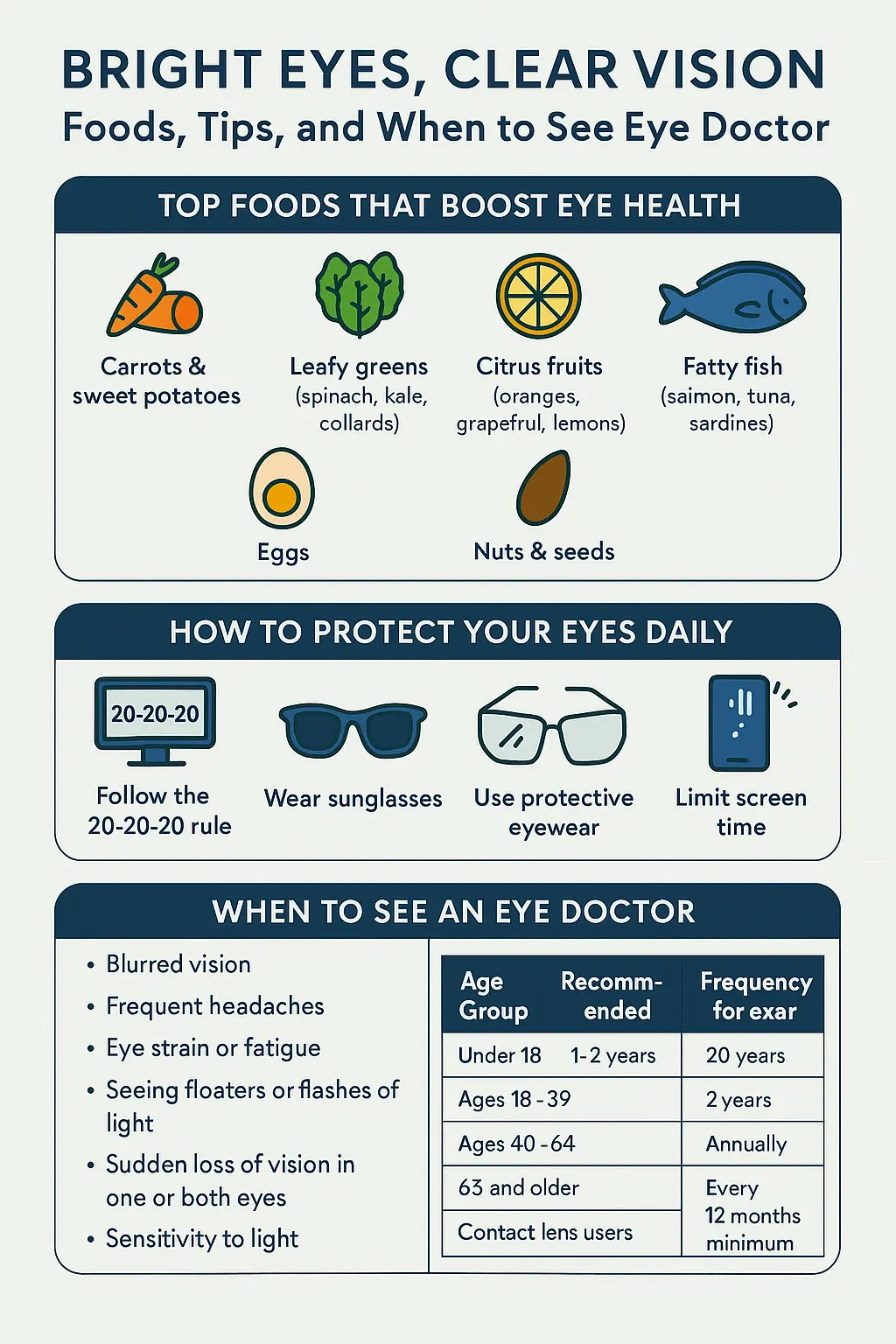Bright Eyes, Clear Vision: Foods, Tips, and When to See the Eye Doctor
Your eyes are your window to the world—so taking care of them should be a top priority. In this post, we’ll break down the best foods for eye health, everyday habits to protect your vision, and signs that it’s time to visit the eye doctor.
Top Foods That Boost Eye Health
What you eat affects how you see. These nutrient-rich foods provide key vitamins and antioxidants to keep your eyes sharp:
1. Carrots & Sweet Potatoes
- Rich in beta-carotene (a type of vitamin A)
- Supports night vision and prevents dryness
2. Leafy Greens (Spinach, Kale, Collards)
- Packed with lutein and zeaxanthin
- Helps reduce risk of macular degeneration and cataracts
3. Citrus Fruits (Oranges, Grapefruit, Lemons)
- High in vitamin C
- Boosts eye tissue repair and protects blood vessels
4. Fatty Fish (Salmon, Tuna, Sardines)
- Loaded with omega-3 fatty acids
- Helps prevent dry eyes and supports retinal health
5. Eggs
- Contain zinc and lutein
- Protects retina and improves vision clarity
Bonus: Nuts & Seeds (Almonds, Sunflower Seeds, Chia)
- Rich in vitamin E – reduces age-related damage
How to Protect Your Eyes Daily
Even with great nutrition, your daily habits can make or break your eye health. Follow these simple steps:
1. Follow the 20-20-20 Rule
Every 20 minutes, look at something 20 feet away for 20 seconds—great for screen-heavy days.
2. Wear Sunglasses
Choose sunglasses with 100% UV protection to block harmful rays that can speed up cataracts and retinal damage.
3. Use Protective Eyewear
Whether you’re working with tools or playing sports—wear goggles or safety glasses to avoid accidents.
4. Limit Screen Time
Blue light from devices can strain your eyes. Use blue light filters, lower screen brightness, and take regular breaks.
5. Keep Lenses Clean
If you wear contacts or glasses, always clean them properly. Dirty lenses can lead to infections or blurry vision.
When to See an Eye Doctor
Your eyes won’t always tell you when something’s wrong—so don’t wait. Schedule an eye exam if you notice:
- Blurred vision
- Frequent headaches
- Eye strain or fatigue
- Seeing floaters or flashes of light
- Sudden loss of vision in one or both eyes
- Sensitivity to light
How Often Should You Get an Eye Exam?
| Age Group | Recommended Frequency |
|---|---|
| Under 18 | Every 1–2 years |
| 18–39 | Every 2 years |
| 40–64 | Every 1–2 years |
| 65 and older | Annually |
| Contact lens users | Every 12 months minimum |
Final Thoughts: Eye Care is Self-Care
Healthy eyes begin with healthy habits. Eat well, rest your eyes, protect them from harm—and never ignore warning signs. Vision is precious—treat it with the care it deserves.
Want more tips like this? Subscribe to our blog for weekly health guides and wellness tips that keep your body and mind in focus
